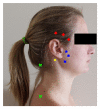Jaw dysfunction is associated with neck disability and muscle tenderness in subjects with and without chronic temporomandibular disorders
- PMID: 25883963
- PMCID: PMC4391655
- DOI: 10.1155/2015/512792
Jaw dysfunction is associated with neck disability and muscle tenderness in subjects with and without chronic temporomandibular disorders
Abstract
Purpose: Tender points in the neck are common in patients with temporomandibular disorders (TMD). However, the correlation among neck disability, jaw dysfunction, and muscle tenderness in subjects with TMD still needs further investigation. This study investigated the correlation among neck disability, jaw dysfunction, and muscle tenderness in subjects with and without chronic TMD. Participants. Forty females between 19 and 49 years old were included in this study. There were 20 healthy controls and 20 subjects who had chronic TMD and neck disability.
Methods: Subjects completed the neck disability index and the limitations of daily functions in TMD questionnaires. Tenderness of the masticatory and cervical muscles was measured using an algometer.
Results: The correlation between jaw disability and neck disability was significantly high (r = 0.915, P < 0.05). The correlation between level of muscle tenderness in the masticatory and cervical muscles with jaw dysfunction and neck disability showed fair to moderate correlations (r = 0.32-0.65).
Conclusion: High levels of muscle tenderness in upper trapezius and temporalis muscles correlated with high levels of jaw and neck dysfunction. Moreover, high levels of neck disability correlated with high levels of jaw disability. These findings emphasize the importance of considering the neck and its structures when evaluating and treating patients with TMD.
Figures
Similar articles
-
Masticatory and cervical muscle tenderness and pain sensitivity in a remote area in subjects with a temporomandibular disorder and neck disability.J Oral Facial Pain Headache. 2014 Spring;28(2):138-46. doi: 10.11607/ofph.1112. J Oral Facial Pain Headache. 2014. PMID: 24829929
-
The association between neck disability and jaw disability.J Oral Rehabil. 2010 Sep;37(9):670-9. doi: 10.1111/j.1365-2842.2010.02098.x. Epub 2010 May 27. J Oral Rehabil. 2010. PMID: 20524969
-
Reduced endurance of the cervical flexor muscles in patients with concurrent temporomandibular disorders and neck disability.Man Ther. 2010 Dec;15(6):586-92. doi: 10.1016/j.math.2010.07.001. Epub 2010 Aug 5. Man Ther. 2010. PMID: 20688556
-
[Neck pain and temporomandibular dysfunction].Ned Tijdschr Tandheelkd. 1996 Jul;103(7):263-6. Ned Tijdschr Tandheelkd. 1996. PMID: 11921900 Review. Dutch.
-
[Diagnosis and classification of temporomandibular dysfunction by the general dental practitioner].Ned Tijdschr Tandheelkd. 1996 Jul;103(7):243-8. Ned Tijdschr Tandheelkd. 1996. PMID: 11921896 Review. Dutch.
Cited by
-
Impact of Cervical Spine Rehabilitation on Temporomandibular Joint Functioning in Patients with Idiopathic Neck Pain.Biomed Res Int. 2021 Oct 7;2021:6886373. doi: 10.1155/2021/6886373. eCollection 2021. Biomed Res Int. 2021. PMID: 34660797 Free PMC article. Clinical Trial.
-
The Usefulness of the Pressure Algometer in the Diagnosis and Treatment of Orofacial Pain Patients: A Systematic Review.Occup Ther Int. 2020 Jun 11;2020:5168457. doi: 10.1155/2020/5168457. eCollection 2020. Occup Ther Int. 2020. PMID: 32684869 Free PMC article.
-
Chronic orofacial pain.J Neural Transm (Vienna). 2020 Apr;127(4):575-588. doi: 10.1007/s00702-020-02157-3. Epub 2020 Mar 4. J Neural Transm (Vienna). 2020. PMID: 32130516 Review.
-
The effectiveness of instrument-assisted soft tissue mobilization on range of motion: a meta-analysis.BMC Musculoskelet Disord. 2024 Apr 23;25(1):319. doi: 10.1186/s12891-024-07452-8. BMC Musculoskelet Disord. 2024. PMID: 38654270 Free PMC article.
-
Effects of Integrating Jaw Opening and Closing Movements with Active Neck Exercises in the Management of Chronic Non-Specific Neck Pain: A Randomized Controlled Trial.Medicina (Kaunas). 2024 Sep 3;60(9):1437. doi: 10.3390/medicina60091437. Medicina (Kaunas). 2024. PMID: 39336478 Free PMC article. Clinical Trial.
References
-
- Padamsee M., Mehta N., Forgione A., Bansal S. Incidence of cervical disorders in a TMD population. Journal of Dental Rresearch. 1994;73:p. 186.
-
- Oliveira-Campelo N. M., Rubens-Rebelatto J., Martín-Vallejo F. J., Alburquerque-Sendín F., Fernández-De-Las-Peñas C. The immediate efects of atlanto-occipital joint manipulation and suboccipital muscle inhibition technique on active mouth opening and pressure pain sensitivity over latent myofascial trigger points in the masticatory muscles. Journal of Orthopaedic and Sports Physical Therapy. 2010;40(5):310–317. doi: 10.2519/jospt.2010.3257. - DOI - PubMed
Publication types
MeSH terms
LinkOut - more resources
Full Text Sources
Other Literature Sources
Medical


